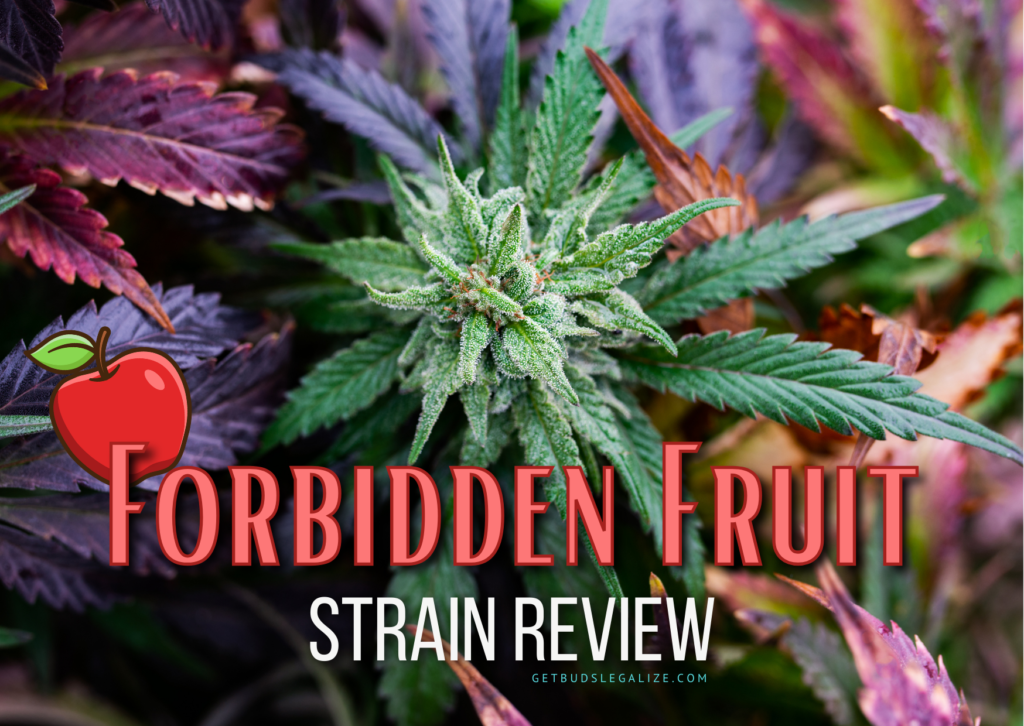Forbidden Fruit Strain Review & Growing Guide
Forbidden Fruit is a cannabis strain that features both sativa and indica qualities. It is a hybrid of Cherry Pie and Tangie strains, with a ratio of 70% indica and 30% sativa, making it the perfect balance between the two types.
In addition to its many desirable characteristics, Forbidden Fruit is also known for its high THC content, making it a potent strain. Laboratory tests show that it contains an average of 15% to 20% THC, with some exceptional cases reaching 25%.
Forbidden Fruit Strain Effects
If you are looking for a strain that can help you forget your worries and improve your mood, then Forbidden Fruit is an excellent choice.
Its effects are both exhilarating and relaxing, providing a deep trance-like state that can ease the mind and relax the body. It can help you enter a meditative state of mind, leaving your worries behind.
This strain has a powerful effect that can make you feel sleepy and inebriated. It is perfect for reducing minor physical discomforts, relieving stress, and rebalancing mood.
Keep in mind that this is a very strong strain, so it is best consumed in low to medium doses to avoid feelings of paranoia, preferably in the evening.

Forbidden Fruit Terpenes
Terpenes are the aromatic compounds that give marijuana its distinctive smell and taste. They also have various effects on the body and mind, depending on their type and concentration. Forbidden Fruit has a rich and diverse terpene profile, with the following terpenes being the most dominant:
Dominant terpene:
| Terpene | Characteristics |
| Myrcene | earthy, musky, fruity, clover, hop, pungent |
Myrcene is the most abundant terpene in Forbidden Fruit, as well as in many other Indica strains. It has a musky and earthy aroma, and it is known for its sedative and anti-inflammatory properties. Myrcene can also enhance the effects of THC, making this strain more potent and relaxing.
Secondary terpenes:
| Terpene | Characteristics |
| β-Caryophyllene | spicy, cinnamon, clover |
| D-Limonene | citrus, lemon, orange, tangerine |
| Humulene | hops, earthy, wood, herbal |
| Fenchol | pine, lemon, camphor |
| Linalool | floral, lavender, rose, citrus, wood, rosewood |
- β-Caryophyllene is the second most prevalent terpene, and it has a spicy and peppery scent. It is unique among terpenes because it can bind to cannabinoid receptors in the body, acting as a natural anti-inflammatory and analgesic. β-Caryophyllene can also help reduce anxiety and depression, making Forbidden Fruit more uplifting and mood-enhancing.
- D–limonene is the third most abundant terpene in Forbidden Fruit, and it has a citrusy and fresh aroma. It is common in many fruits, especially lemons and oranges. D–limonene can boost the immune system, fight infections, and improve digestion. It can also elevate the mood, relieve stress, and counteract the couch-lock effect of this strain.
- Humulene is another terpene that has an earthy and woody smell, similar to hops. It can suppress appetite, reduce inflammation, and fight cancer cells. Humulene can also balance the effects of Forbidden Fruit, making it more mellow and soothing.
- Linalool is a terpene that has a floral and lavender-like scent. It can calm the nerves, relax the muscles, and induce sleep. Linalool can also enhance the flavor of Forbidden Fruit, making it more sweet and pleasant.

Aroma & Flavor
The Forbidden Fruit strain has a delightful aroma that’s quite overwhelming. It exudes a sweet fragrance of flowers and fruits, with a hint of pine. The scent is followed by a tangy lemon flavor that’s mixed with sweet berries.
Furthermore, this strain is known for its unique and seductive taste. It has tropical and citrusy flavors, similar to that of cherry or grapefruit, with hints of mango, pine, and passion fruit. The combination of these flavors is perfectly balanced, without being too strong.
Many loyal fans of this marijuana strain claim that it’s one of the best-tasting strains they have ever experienced.
Adverse Reactions
While Forbidden Fruit has no reported adverse side effects, it can still cause dry mouth and dry, red eyes like any other strain of cannabis.
Medical
This particular strain of marijuana has been carefully developed to provide a balanced effect, making it a great option for treating a variety of ailments.
People have reported using the Forbidden strain to relieve migraines, chronic pain, and muscle spasms, as well as to manage chronic stress, anxiety disorders, nausea, and lack of appetite.
If you are someone who has trouble falling asleep at night due to an overactive mind or anxiety issues, this strain may be especially helpful to you.
However, it is important to note that using large quantities of Forbidden Fruit could lead to a couch lock, which may be desirable if you are feeling particularly stressed.

Forbidden Fruit Grow Info
Cultivating the Forbidden Fruit requires some experience and skill, but is not overly challenging. This strain produces compact, trichome-covered buds, making it an attractive option for many growers.
While it is possible to grow outdoors in a mild climate, growing indoors is generally preferable. If you choose to grow outdoors, use organic soil with added nutrients and keep the soil moist but not overly wet.
Unlike other varieties, Forbidden Fruit is resistant to common problems like mold and rot, making it a more reliable choice for growers.
Indoor growers will have an easier time with this strain, as it performs well in normal room temperatures and moderate humidity.
However, her indica foliage makes her more suitable for intermediate growers, as she can spread out and become bushy, making it difficult to ensure adequate light exposure.
Forbidden Fruit Flowering Time
Indoors
If you decide to cultivate Forbidden Fruit indoors, it’s important to ensure that it receives sufficient lighting, ventilation, and humidity. You can opt for either soil or hydroponics as your growing medium, but it’s essential to regulate the pH level accordingly.
Employing certain training techniques, like topping or pruning, can help you manage the plant’s height and shape. Forbidden Fruit typically blooms for 8 to 10 weeks indoors.
Outdoors
If you plan to grow forbidden fruit outdoors, it is crucial to select a location that receives ample amounts of sunlight and has adequate air circulation. Furthermore, you will have to safeguard the plant from frost and extreme temperatures.
You can plant it directly in the ground or in large pots, but be sure to provide enough space for the plant to spread its branches. The forbidden fruit will be ready for harvest from late September to early October if grown outdoors.

Forbidden Fruit Yield
Forbidden Fruit produces high yields both indoors and outdoors. It can yield up to 15 ounces per square meter indoors, and around the same amount per plant outdoors.
Origin
The Forbidden Fruit is an Indica dominant hybrid strain that is a cross between Cherry Pie and Tangie, two incredibly potent and flavorful strains.
Tangie also known as Tangerine Dream, a Sativa-dominant strain, was bred by DNA Genetics and the Crockett Family Farms, It gained popularity in the 90s due to its uplifting effects and intense citrusy flavor but eventually fell out of favor.
On the other hand, Cherry Pie is a well-balanced 50-50 strain bred by the Cookie Family Genetics. It has a deliciously sweet and funky taste of dough and cherry, providing an enjoyable and relaxing full-body buzz.
The Forbidden Fruit has a genetic profile that is heavy on fruity flavors and enchanting effects, resulting from the mixture of these two strains.
FAQs about Forbidden Fruit Weed Strain
Forbidden Fruit is a high-yielding strain suitable for both indoor and outdoor cultivation. Indoor growers can yield up to 15 ounces of buds per square meter, while outdoor growers can harvest around the same amount per plant.
Forbidden Fruit is a strain of cannabis with moderate to high THC levels, ranging from 14% to 17%, and low CBD levels, less than 1%.
Growing Forbidden Fruit is best done indoors as it allows for better control of temperature and humidity levels. However, if you choose to grow the plant outdoors, make sure to use organic soil that has good drainage and maintains a balanced moisture level.
This strain is known to be resistant to common pests and diseases that affect other marijuana plants such as mold and rot. However, it has a bushy and dense structure which can make it challenging to provide adequate light to all branches and leaves. To improve the yield and quality, pruning and training the plant may be necessary.
The Forbidden Fruit weed has a predominantly calming and uplifting effect, which can lead to a feeling of euphoria and relaxation. Users may also experience heightened creativity and a greater appetite.
While the strain isn’t known to have any significant negative side effects, some common side effects of cannabis may still occur, including dry mouth, dry eyes, and paranoia, as reported by users.
Forbidden Fruit is a hybrid strain that blends the citrusy Tangie with the sweet Cherry Pie. This Indica-dominant strain has a 70/30 split in favor of Indica.
Forbidden Fruit has a distinctive and appealing flavor profile. It combines floral notes with lemony accents and a nutty undertone.
Forbidden Fruit strain info:
Characteristics:
- Genetics: Tangie x Cherry Pie
- Variety: Sativa 30% Indica 70%
- Sex: Feminized seeds
- THC: 14 to 17%
- CBD: < 1%
- Climate: Sunny Mediterranean outdoor climate
- Difficulty: Medium
- Yield High: indoor 15 oz/m2, outdoors 15 oz/plant
- Flowering: indoor 10 weeks, outdoor late September or early October
- Taste & Smell: Lemon, citrus, flowers
- Effect: Euphoria and calmness
- Medical uses: Eases migraines, chronic pain, and muscle spasms

These Are Some Other Popular Cannabis Strains That You Might Enjoy:



ILGM Fertilizer

- From seedling to harvest, give your plants everything they need.
- Enough for feeding at least 5 plants.
- Discounted Package Deal
- Works well in soil, hydroponics, and other growing mediums.
- The best way to treat your plants
ILGM Plant Protector

- Protect your cannabis from diseases and harmful pests.
- Contains three 20 ml bottles.
- Enough supplies to protect 20 plants.
- It can be used in soil, hydroponic, and all other growing mediums.




















